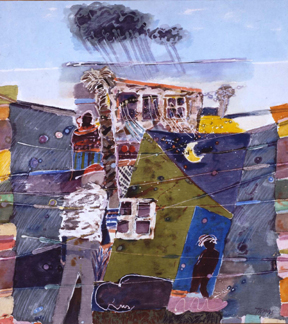

| For more information about this article or gallery, please call the gallery phone number listed in the last line of the article, "For more info..." |
May Issue 2004
Gibbes Museum of Art in Charleston, SC, Presents Exhibitions by Leo Twiggs and Jonathan Green
The Gibbes Museum of Art in Charleston, SC,
will feature two exhibitions, as part of the Spoleto Festival
USA, including: Myths and Metaphors: The Art of Leo Twiggs
on view from May 18 through Aug. 8, 2004 and Rhythms of Life:
The Art of Jonathan Green on view through May 28 through Aug.
29, 2004.
 Leo Twiggs
Leo Twiggs
Organized by the Georgia Museum of Art, this
compelling exhibition of over 40 oil and batik paintings, is the
first ever retrospective of Leo Twiggs. Twiggs has earned national
acclaim as a leading African American artist of the post-1945
generation and through his studies at Claflin College, the Art
Institute of Chicago, with famed Harlem Renaissance artist Hale
Woodruff while earning a MA.from New York University, and ultimately
a doctorate at the University of Georgia.
Well known for pioneering the process of batik in contemporary
American art, Leo Twiggs creates provocative works that tell stories
about life experiences in the South. Myths and Metaphors: The
Art of Leo Twiggs exemplifies how Twiggs' work embraces the
use of private narrative stemming from his personal memories of
family and friends. The imagery may recall the places or interiors
of his childhood and the people who inhabited these spaces. Twiggs'
images reveal the idea of family, the interconnectedness of generations
and the importance of music, poetry, faith and spirituality in
our daily lives.
One of the most difficult and compelling themes
Twiggs has explored throughout his career is the meaning of commemoration
in the form of the Confederation battle flag. In the series Commemoration,
Twiggs reflects on the insistence of some southerners to highlight
their Confederate past. Commemoration addresses Twiggs'
intense desire to contradict the traditional authority of the
Confederate flag as a symbol. This series, as with the majority
of Twiggs' work, is full of complexities and richness, providing
visually compelling images that include thought-provoking challenges.
This exhibition is made possible through the generous support
of Gibbes, Etc. Additional media support provided by WHERE
Charleston magazine.
 Jonathan
Green
Jonathan
Green
The concept of rhythm became the unifying perspective of the exhibition, Rhythms of Life: The Art of Jonathan Green, as a way of examining Jonathan Green's search for a universal and vital humanism rooted in his Gullah heritage - the distinctive, long-surviving African American culture of the coastal islands of South Carolina and Georgia. This selection of 30 paintings shows his development from 1985 to the present as he progressed from an early modernist primitivism to the bold, flat, brilliantly colored style of the 1990s that initially earned his wide reputation and success, to his introduction of more dimensional, detailed, and figurative representation in many of his recent works.
Born in 1955 in the Gullah community of Gardens Corner, SC, Green began drawing as a youth and continued his interest in art at Beaufort High School. Following graduation, he served in the United States Air Force where he worked and was certified as an illustrator. He also studied textile design and construction at East Grand Forks Technical Institute in Minnesota prior to entering the School of the Art Institute of Chicago in 1978. Green graduated from the Art Institute with a BFA in 1982, and for the next few years traveled in the United States, Canada, Mexico, West Indies, England, France and Switzerland. Settling in Naples, FL, in 1985, he began to paint his distilled, evocative visions of the Lowcountry black culture.
The broad meanings of rhythm can be traced in Green's paintings of the past 20 years in both style and content. Green frequently uses repeated and contrasting figures, elements, or patterns to create strong visual rhythms, as in Down to the River (1988), with its haunting procession of congregants headed to a river baptism. Characteristic themes, like spiritual worship, farming, fishing, domestic work, dancing, and family gatherings, reveal an artistic view of life as rhythmic in its flow and rituals. Several examples show Green's focus on the rhythms of nature as experienced in the ongoing cycles of tides, seasons, days and nights, and in the regular occurrence of life passages like baptisms, holidays, burial, or by contrast, the glamorous night-time socializing and dancing of The Silver Slipper Club (1990).
This exhibition is made possible through the generous support of Wachovia Bank, N.A. Additional media support provided by The Post and Courier.
There are several related programs being offered in conjunction with these exhibitions. Contact the Gibbes for further information.
For additional information, to request an interview, or to request images for publication, please contact Kelly A. Linton at 843/722-2706, ext. 38, or at (www.gibbesmuseum.org).
Carolina Arts is published monthly by Shoestring Publishing Company, a subsidiary of PSMG, Inc. Copyright© 2004 by PSMG, Inc., which published Charleston Arts from July 1987 - Dec. 1994 and South Carolina Arts from Jan. 1995 - Dec. 1996. It also publishes Carolina Arts Online, Copyright© 2004 by PSMG, Inc. All rights reserved by PSMG, Inc. or by the authors of articles. Reproduction or use without written permission is strictly prohibited. Carolina Arts is available throughout North & South Carolina.